|
Michael McFadyen's Scuba Diving - Apollo Barge
Another of the scuttled wrecks at Long Reef on Sydney's Norther Beaches is a large barge. I do not know the real name of this wreck but some people call it the Apollo Barge. It was discovered by Peter Fields and John Riley while searching for the SS Myola but I think that I hooked onto it a few years before when doing decompression after diving one of the other wrecks. It is located 1.2 kilometres south-south-west of the SS Dee Why and Meggol/Doomba.
I have no information yet as to its real identity, any information would be appreciated (Peter and John called it Apollo as they were being sponsored by Apollo dive gear at the time). There are many other pieces of "rubbish" dumped out in this area, including the "No Frills Barge", the Sutherland Caisson and other similar barges. It was probably scuttled about 1980 give or take five years.
This wreck is a dumb barge (an unpowered barge) about 60 metres long. It is about 10 metres wide and 6 metres deep. It has one large hold divided into two sections. There is also a bridge and an engine room. More about all this later. The wreck appears to be a hopper or dump barge. This is a barge that carries material and then dumps it at sea. The material could be placed into the barge from the shore by grab claw, conveyor belt or pumped. It could also be placed in the barge from a water based vessel, such as a dredge. Again, this would most likely be by a pump or a grab claw. I have no idea how this vessel was loaded. In any case, once the material was in the barge, the vessel was moved out to sea by a tug boat and once on site, it dumped its load by opening the bottom of the hull below the holds and the material falls out to the bottom of the sea.
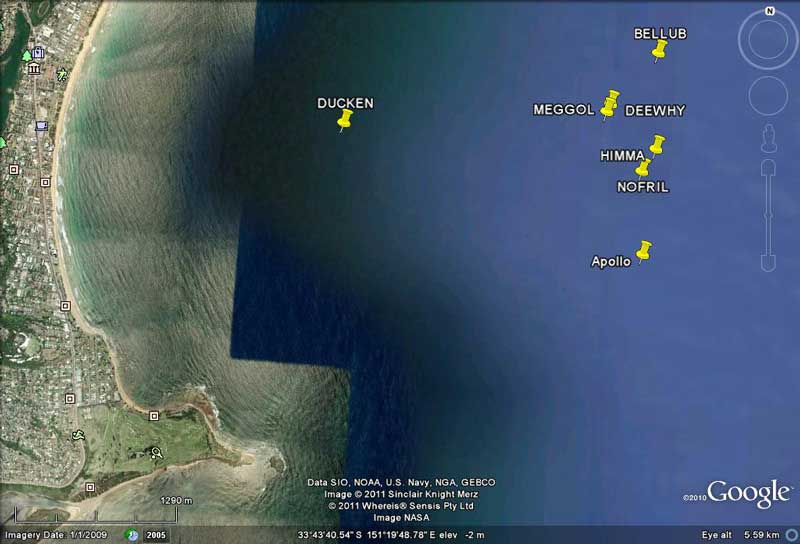 |
A satellite photograph of the coast north east of Long Reef showing the location of the scuttled wrecks
The Apollo Barge is clearly identified |
To find the wreck, travel north 11.6 kilometres from Sydney Harbour till you are just past Long Reef but south of the normal shipwreck site. GPS marks of 33° 43' 40.6"S 151° 20' 58.8"E (using datum of AUS66) puts you on the wreck. Check my GPS page for details about datums etc. The depth will be about 45 to 47 metres. The wreck is quite large, coming up to 41 metres. Manoeuvre over the wreck and drop anchor. Unless you drop right on the wreck you are unlikely to drag back onto it. This should put you in the area of the bow. Note that the bottom is composed of sand with isolated rocks. It is very possible that your anchor may hook onto one of the rocks, so make sure that you are on the wreck or at least very close before descending.
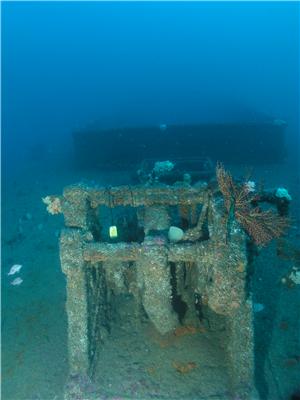 | 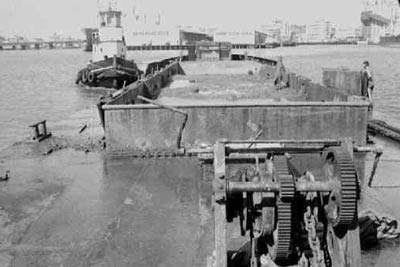 |
Looking towards the stern from the bow. Note the anchor
winch in front and the main hold behind. The hatch
giving access to the bow compartment is the
small hatch behind the winch - The small yellow
object hanging on left side of winch is a mobile phone - why? | This barge appears to be identical to the Apollo Barge,
note the winch, hatch and hold |
Once on the bottom, if you are at the bow (as you should be using the GPS co-ordinates), have a look at the bow itself. This is a very blunt bow, not sharp and well rounded. A good photograph can be taken by moving out in front of the wreck and looking back. On the bow there is a winch that used to lift the anchor/s. In May 2005 there was a mobile phone hanging off the winch - why? Behind this there is a hatch that gives access to the compartment under the bow. The hatch is quite large and the compartment is also very large. However, there is a considerable amount of silt in the compartment so be careful if you decide to enter it as it can get very silted up. On your first dive here I would just quickly drop into the hatch for a look.
Behind the hatch is the main hopper hold. This is split into two parts, with each part having (I think) two sets of doors. The doors are how the material in the hold is dropped to the bottom of the sea. The doors open downwards, with one door on each side of the ship. These are operated by chains. More about this later.
As you swim along the hold, you will see that each door has two chains running up from the door to the deck. Some of these holds have fish such as bastard trumpeters in them. The rear one normally has a large school. You may also see jewfish in the holds. About half way along the hold you will see that the hold is sort of divided into two, although the dividing wall is not quite as impressive as you would imagine.
Behind the hold is another hatchway. This is large and if you look down you will see as set of stairs that goes right to the bottom of the vessel. This is the engine room. For the first dive, do not enter. A metre or two towards the stern you will see the engine room skylights. If you look down through the skylights and you will see the engine. This is a smallish three cylinder diesel engine. Of course, it is not as big as you would normally find in a vessel of this size as the engine did not provide propulsion power to the vessel. It only provided power to the winches and the hold doors. More about the door mechanism shortly.
Behind the skylights is the hold door mechanism. This operates on a pulley system from the engine and as it turns, it pulls a cable through two pulleys (one on each side of the vessel) forward of the mechanism. This provides a multiplier effect of (I think) four. The pulley then pulls a bar that runs all the way along the sides of the holds. This lifts the chains and opens the doors, letting the material drop out of the barge.
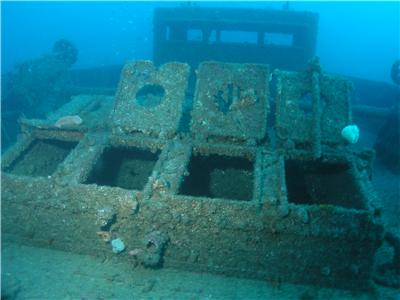 | 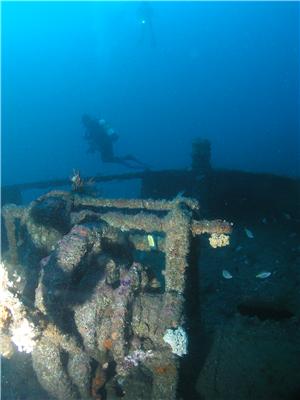 |
| The engine skylights and the bridge behind | The bow of the Apollo and its anchor winch
Peter Fields up high and Brendan Poole lower |
Right at the stern is the bridge. This is not all that big but can easily be accessed via the doors on either side of the bridge. There is nothing really to see inside.
Behind the bridge there is (I think) a small hatch. I may be wrong on this. Once at the stern, drop over the back a little and you again get a very good view of the wreck. Note that there is no prop although there is a rudder (I think) and some very large rust holes in the hull just below what would have been water level.
Swim back to the bow along one side of the wreck. You will notice that there are a number of hatches. These are quite small and it would be very dangerous to try to enter them. The give access to the hull sections that provide the lift for the vessel (remember that the majority of the hull opens to the ocean). Once back at the bow it will probably be time to ascend, although you may have time to explore the bow compartment or the bow itself
This is a very interesting wreck, well worth a number of dives. Of course, like all deep wrecks, this is only for the experienced and properly equipped deep diver. Visibility is normally quite good, in the order of 15 to 20 metres. Current is not normally a concern.
HELP
If you know any more information about the "Apollo", please email me.
| 
 v6.00.307 © 2003-2005
v6.00.307 © 2003-2005